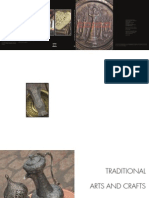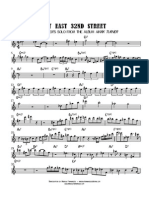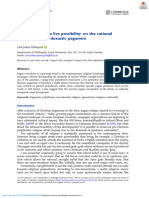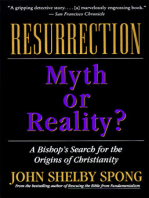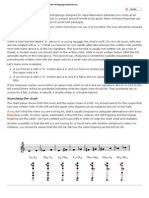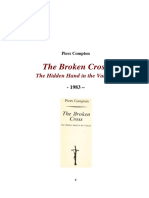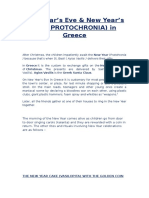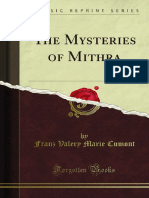Jah 2014 0010 PDF
Jah 2014 0010 PDF
Uploaded by
Gabriel SternCopyright:
Available Formats
Jah 2014 0010 PDF
Jah 2014 0010 PDF
Uploaded by
Gabriel SternOriginal Title
Copyright
Available Formats
Share this document
Did you find this document useful?
Is this content inappropriate?
Copyright:
Available Formats
Jah 2014 0010 PDF
Jah 2014 0010 PDF
Uploaded by
Gabriel SternCopyright:
Available Formats
JAH 2014; 2(1): 64–77
Jerry B. Brown and Matthew Lupu
Sacred Plants and the Gnostic Church:
Speculations on Entheogen-Use in Early
Christian Ritual
Abstract: It is the aim of this paper to establish a temporal and cultural link
between entheogen-use1 in Classical mystery cults and their possible use in a
segment of the early Christian Gnostic Church. As early Christianity was heavily
influenced by the Classical world in which it first developed, it is essential to
examine the evidence of entheogen-use within Classical mystery cults, and ex-
plore their possible influence on the development of Christian ritual. We will first
present textual evidence from the New Testament and Nag Hammadi Library
(NHL) that indicate possible use of ritual entheogens. Next we will examine
entheogen-use by some of the main religious sects of the ancient Mediterranean
world as part of their liturgical practice between c. fifth century BCE and the third
century CE. Then we will show that the different schools of philosophical thought
examined were quite fluid, and that there was considerable overlap among
schools with respect to several key philosophies and practices. Ultimately the
subject of entheogen-use in the Classical world necessarily falls into the realm of
plausible speculation mainly due to the lack of primary sources. However, should
the entheogenic hypothesis2 prove to be correct, it promises to be quite useful in
future research and in the translation of original documents.
Keywords: Gnosticism, Entheogens, Early Christianity, Neoplatonism, Mystery
Cults
DOI 10.1515/jah-2014-0010
1 Entheogen as a neologism roughly translates as “God generated within,” and was first coined
in 1979 by R. Gordon Wasson, and Carl A. P. Ruck as a replacement for the more widely known
terms “hallucinogen” or “psychedelic.” Ruck felt that the term hallucinogen alluded to insanity,
and psychedelic had been co-opted by Timothy Leary and his followers. In this paper, the terms
“entheogens,” “sacred plants,” and “visionary plants” are used interchangeably.
2 We define “entheogenic hypothesis” here as the idea that visionary plants were an integral part
of ancient religious practice, usually reserved for more advanced levels of initiation into local
religious cults.
Jerry B. Brown: Florida International University, Department of Global & Sociocultural Studies,
E ˗ Mail: jbbrown@gate.net
Matthew Lupu: Florida International University, Department of Global & Sociocultural Studies,
E ˗ Mail: matt.lupu@gmail.com
Brought to you by | provisional account
Unauthenticated | 70.191.89.91
Download Date | 5/27/14 4:09 PM
Sacred Plants and the Gnostic Church 65
Although well-documented in tribal and Classical cultures,3 the use of visionary
plants in early Christian religious practice has long been a controversial topic.
Ever since John Marco Allegro published The Sacred Mushroom and the Cross in
1970, the topic of entheogenic influences in early Christianity has been met with a
mixture of scorn and willful ignorance by mainstream academia. The scorn is not
terribly surprising, given Allegro’s sometimes polemical treatment of the Catholic
Church in his book and careless use of key linguistic data. However, one could
argue that the willful ignorance seems to stem from mainstream academics’
desire to avoid the controversy that inevitably surrounds this topic.
Undertaking this type of research is reminiscent of the efforts of R. Gordon
Wasson in his groundbreaking study of ancient entheogens, most notably, his
assertion that the Soma plant of the Rigveda was in fact the hallucinogenic
Amanita Muscaria mushroom.4 Wasson later went on to claim, along with co-
authors Albert Hoffman, the discoverer of LSD, and Carl A. P. Ruck, professor of
classics at Boston University, that the identity of the kykeon used in the Eleusinian
Mysteries was also a hallucinogenic substance, most probably a type of ergot
parasitism.5 Both of these works remain controversial today, although there has
been widespread acceptance of Wasson’s Soma theory in anthropological circles.
A small but growing number of researchers and academics have tried to pick up
where Wasson has left off with mixed results at best.6 It is our contention that
there is significant textual evidence that suggests the use of visionary plants
throughout the ancient world in a wide variety of settings.
Our understanding of the Gnostic Church has only been illuminated by the
discovery of the Gnostic Gospels, a collection of about 52 papyrus volumes
compiled between the second and fourth centuries CE. They were found in the
late 1940s outside the Upper Egyptian town of Nag Hammadi. Upon their discov-
ery, several of the volumes were burned for fuel, so the true extent of the library
may never be known for certain. They were apparently a library deemed impor-
tant enough to be deliberately hidden in large earthenware vessels in a cave
system, possibly indicating their holy status by a sect of Gnostic Christians living
in the area.7 Final translation of these works from Coptic into English was not
3 Furst (1976).
4 Wasson (1968).
5 Wasson (1978).
6 See, for example J. R. Irvin’s The Holy Mushroom Evidence of Mushrooms in Judeo-Christianity
(2008); Carl Ruck’s The Apples of Apollo Pagan and Christian Mysteries of the Eucharist (2001); Dan
Merkur’s The Mystery of Manna (2000); Franco Fabbo’s Did Early Christians Use Hallucinogenic
Mushrooms (1996).
7 Robinson (1978), 1.
Brought to you by | provisional account
Unauthenticated | 70.191.89.91
Download Date | 5/27/14 4:09 PM
66 Jerry B. Brown and Matthew Lupu
completed until 1977.8 It must be noted that work on these texts is ongoing, and
that many volumes within the NHL exist only as fragments.
While the contention that entheogen-use predated the compilation of the
NHL is backed in part by the archaeological record,9 establishing the veracity of
any of the multiple entheogenic theories is problematic, because they are inher-
ently unknowable or impossible to document. While we may never find definitive
proof for any of the entheogenic theories, we certainly can analyze the extant
texts and draw inferences when appropriate, which is what leading scholars in
this field have done.
I Textual Clues from the Gnostic Gospels and
Old Testament
Before the discovery of the NHL, Gnosticism was seen as a highly esoteric field of
study relegated to students of divinity or to Christian heresiologists. That was
because most evidence relating to a “Gnostic School” was preserved in the form
of condemnations issued against it by early Christian leaders.10 With the discovery
of the NHL, researchers finally had access to Gnostic philosophy written by the
original proponents of this worldview. While these documents are invaluable to
our understanding of Gnosticism, their evidentiary value is inherently limited. We
have no extant contemporary commentary on Gnosticism written by Gnostics. All
we have are modern interpretations and ancient invectives.
According to modern research, the path to Gnostic enlightenment apparently
revolved around gaining otherwise hidden spiritual knowledge, or Pleroma,
trapped inside all human souls, along with personal insights into certain esoteric
levels of the cosmos.11 This acquisition of cosmic knowledge appears to have
taken many different forms. Some Gnostic adherents are known to have partici-
pated in not just one baptism, but several baptisms, as a form of initiation into the
church.12 These baptismal rituals are referenced in several of the NHL tractates.
Take for example, Allogenes 52:
8 Robinson (1978), IX.
9 Merlin (2003).
10 Pagels (1979), XVII.
11 Pagels (1979), 144.
12 Turner (1994).
Brought to you by | provisional account
Unauthenticated | 70.191.89.91
Download Date | 5/27/14 4:09 PM
Sacred Plants and the Gnostic Church 67
“… my soul went slack and I fled and was very disturbed. And I turned to myself and saw the
light that surrounded me and the Good that was in me, I became divine. And the all glorious
One, Youel anointed me again and she gave power to me. She said ‘Since your instruction
has become complete and you have known the Good that is within you, hear concerning the
Triple-Powered One those things that you will guard in great silence and great mystery,
because they are not spoken to anyone except those who are worthy, those who are able to
hear; nor is it fitting to speak to an uninstructed generation concerning the Universal One
that is higher than perfect. But you have these because of the Triple-Powered One, the One
who exists in blessedness and goodness, the One who is responsible for all these.”13
Following baptism, Gnostics participated in a ritual investiture, chrismation with
oils, a Eucharist, and a sacral marriage.14 Some of these rituals appear to be
connected to more advanced initiation into the church, and thus are reserved for
only the few deemed spiritually ready for advanced teaching.15 The common
theme to most of these rituals appears to be the acquisition of divine knowledge
through visionary experience.
Also of interest is the apparent call for secrecy that follows the spiritual
experience of Allogenes. This call for secrecy is reminiscent of the similar secret
nature of Mystery Cult indoctrination. For example, Tertullian (Adversus Valenti-
ninos 1.1–2), goes so far as to compare directly the Gnostic Church ritual to the
Eleusinian mysteries:
“They [Valentinian Gnostics] preach confusion while (seemingly) asserting their piety. In
just the same way concerning the Eleusinian mysteries, itself a heresy of Athenian pagan-
ism; the fact that they keep silent about these mysteries makes them an object of shame.
Consequently the ‘mystagogues’ make entry difficult and perform long initiation rites before
they accept the devotee; they put him on probation for five years in order to increase his
anticipation by suspense and in this manner cause the awesomeness of their rites to match
the desire which has been elicited. Their duty of secrecy is a natural consequence …”16
One thing that is clear from modern scholarship on the NHL is that the Gnostics
saw themselves as being a part of mainstream Christianity. For example, Valenti-
nus, the founder of the eponymous school of Gnosticism, likely started his career
in the Orthodox Church before founding his own school. In fact Valentinian
Gnostics considered themselves to be full members of the Orthodox Church and
resisted attempts to be expelled.17 Based on this close relationship between
13 Robinson (1978), 494. All translations from NHL are Robinson’s.
14 Turner (1994).
15 Pagels (1979), 140.
16 Translation from Riley (1971), 73.
17 Pagels (1979), 39.
Brought to you by | provisional account
Unauthenticated | 70.191.89.91
Download Date | 5/27/14 4:09 PM
68 Jerry B. Brown and Matthew Lupu
Orthodoxy and Gnosticism, one can infer that Gnostic Christians would have
readily accepted the Old Testament.
There has been some recent speculation over references to entheogen-use
within the Old Testament.18 Perhaps the most convincing quotation suggesting
Old Testament entheogen-use comes from 2 Esdras19 which is classified among
the Apocrypha in most Christian traditions.
“And the next day, behold, a voice called me, saying, Esdras, open thy mouth, and drink
that I give thee to drink. Then opened I my mouth, and behold, he reached me a full cup,
which was full as it were with water, but the color of it was like fire. And I took it, and drank:
and when I had drunk of it, my heart uttered understanding, and wisdom grew in my breast,
for my spirit strengthened my memory: And my mouth was opened, and shut no more. The
Highest gave understanding unto the five men, and they wrote the wonderful visions of the
night that were told, which they knew not: and they sat forty days, and they wrote in the
day, and at night they ate bread. As for me I spake in the day, and I held not my tongue by
night. In forty days they wrote two hundred and four books. And it came to pass, when the
forty days were fulfilled, that the Highest spake, saying, The first thou hast written publish
openly, that the worthy and unworthy may read it: But keep the seventy last that thou
mayest deliver them only to such as be wise among the people: For in them is the spring of
understanding, the fountain of wisdom, and the stream of knowledge. And I did so.”20
It is most interesting to note yet again the call for secrecy at the end of the
passage. The original date of composition for 2 Esdras is thought to be between
100 and 120 CE, which would make it contemporaneous to several different
Gnostic factions.21 The overall theme of the book is one of an imminent apoc-
alypse which is very much in keeping with the eschatological nature of both
Orthodox and Gnostic Christianity, and to a lesser extent Judaism of the time.
But the references to entheogenic substances do not end with the apocrypha.
Of the many plants mentioned within the Old Testament, one deserves special
attention. The Mandrake plant has been known to have psychoactive properties
going back to its recommended use as a surgical anesthetic by Dioscorides in the
first century CE.22 Throughout the Middle Ages, Mandrake became associated
with magic and witchcraft because of its anthropomorphic root, and its narcotic
18 See Shanon (2008); Merkur (2000).
19 We are using the naming convention found in the KJV Bible as opposed to the original name
found in the Latin manuscripts: Esdrae Liber IV. As a result some scholarly literature refers to this
same passage as Ezra 4.
20 2 Esdras 14:36–48 (KJV).
21 Metzger (1983).
22 De Materia Medica 4.
Brought to you by | provisional account
Unauthenticated | 70.191.89.91
Download Date | 5/27/14 4:09 PM
Sacred Plants and the Gnostic Church 69
and hallucinogenic properties.23 Presumably it is this same Mandrake that ap-
pears in the book of Genesis:
And Reuben went in the days of wheat harvest, and found mandrakes in the field, and
brought them unto his mother Leah. Then Rachel said to Leah, Give me, I pray thee, of thy
son’s mandrakes. And she said unto her, is it a small matter that thou hast taken my
husband? And wouldest thou take away my son’s mandrakes also? And Rachel said, There-
fore he shall lie with thee to night for thy son’s mandrakes. And Jacob came out of the field
in the evening, and Leah went out to meet him, and said, Thou must come in unto me; for
surely I have hired thee with my son’s mandrakes. And he lay with her that night.24
It remains unclear as to whether this Mandrake refers to the same Mandrake
known to cause hallucinations by modern science, or some other plant with
fertility properties. At any rate, it is certainly intriguing to note that a direct
reference to a potentially psychoactive plant makes an open appearance in the
document most fundamental to the Abrahamic religions.
Several other passages of note appear in the NHL that, to this day, are not
well understood at all. However, the entheogenic theory promises to provide a
simple and elegant solution to their exact meaning. For example, in several of the
NHL tractates there appear long strings of vowels and consonants that seem to
represent either chanting or hissing. One of these strings of repetitive consonants
and vowels appears in Allogenes 53:33:
“… and the power appeared by means of an activity that is at rest and silent, although it
uttered a sound thus: zza zza zza. But when she heard the power and she was filled […] thou
art […] Solmis! […] according to the Vitality, that is thine, and the first activity which derives
from divinity.”25
But this is not the only time that “chants” appear within the NHL. In fact longer
strings of consonants and vowels appear within Discourse on the Eighth and
Ninth 56:11–21:
“Let us pray, my father … He is the one who […] the aeon among spirits. He created
everything. He who is self-contained cares for everything. He is perfect, the invisible God to
whom one speaks in silence – his image is moved when it is directed, and it governs – the
one mighty power, who is exalted above majesty, who is better than the honored ones,
Zoxathazo a oo ee ooo eee oooo ee oooooo ooooo oooooo uuuuuu oooooooooooo ooo
Zozazoth.”26
23 Carter (2003).
24 KJV, Genesis 30:14–16.
25 Robinson (1978), 495.
26 Robinson (1978), 324.
Brought to you by | provisional account
Unauthenticated | 70.191.89.91
Download Date | 5/27/14 4:09 PM
70 Jerry B. Brown and Matthew Lupu
And another odd “chant” appears in the same book:
“Grace! After these things I give thanks by singing a hymn to you. For I have received life
from you, when you made me wise I praise you. I call your name that is hidden within me: a
o ee o eee ooo iii oooo ooooo ooo oo uuuuuu oo ooooooooo ooooooooo oo. You are the one
who exists with the spirit. I sing a hymn to you reverently.”27
Pagels has speculated that these strings of consonants and vowels are kinds of
“meditative technique”28 which formed components of a “program of [spiritual]
discipline, like the higher levels of Buddhist teaching.”29 While these consonant
and vowel strings could be interpreted as chants analogous to those used in
Buddhist practice, a much simpler explanation would be that these curious
chants are a result of the influence of common Mediterranean mystery cult
practice which used a combination of chanting, music, and entheogens to induce
a state of religious ecstasy.
II Gnosticism and Neoplatonism in the
Third Century CE
Platonist thought at the time of the writings of the NHL has been categorized by
modern scholars as being part of the Middle and Neoplatonist schools.30 Neopla-
tonism as a philosophical framework was based on the works of Plato, but
differed slightly in its interpretation of Plato’s original works. It began to rise to
prominence in the second and third centuries CE, and shares much in common
with Gnosticism. In fact we know from Plotinus, a Neoplatonist philosopher, that
Gnostics at one point attended his school.31 Not only did Gnosticism and Neopla-
tonism share students, but they also had a markedly similar cosmology, and
probably shared teachers as well. The noted Platonist philosopher Ammonius
Saccas very well might have started his life as a pagan, converted to Christianity,
only to renounce it and revert back to paganism.32 It should be noted that this
man went on to teach Porphyry, one of the founders of the Neoplatonist move-
ment. Both Neoplatonism and Gnosticism seem to be derived from Middle-Plato-
27 Robinson (1978), 326.
28 Pagels (1979), 138.
29 Pagels (1979), 140.
30 Gerson (2008).
31 Robinson (1978), 9.
32 Eusebius, Church History, 6.19.9.
Brought to you by | provisional account
Unauthenticated | 70.191.89.91
Download Date | 5/27/14 4:09 PM
Sacred Plants and the Gnostic Church 71
nist schools of thought. However, there are several major differences between the
two schools in that the Neoplatonist cosmology has no place for Jesus Christ or an
afterlife, but it does affirm the inherent “goodness” of the Demiurge, who was
seen as more of a craftsman than a supreme being.33
In addition to influencing Gnosticism, Platonist thought also influenced
Orthodox Christianity, as well as several of the contemporary pagan mystery
cults. Neoplatonism in particular had a lasting influence on Orthodox Christianity
through the writings of Augustine of Hippo.34 One such influence was the idea of
salvation through good works or proper behavior.35 This worldly path to salvation
is common to Gnostics, the Orthodox Church, and the cult of Serapis. For a brief
side-by-side comparison of each philosophical school, see Figure 1.
Figure 1: Contemporaneous Religious Sects in the Mediterranean c. First to Fourth Centuries CE.36
Gnostics Neoplatonists Mystery Cults Orthodox
c. 1st–3rd CE c. 2nd–4th CE (e.g. Serapis) Christians
c. 5th BCE–4th CE c. 1st CE-present
Basic There are several The same as the The multiple gods There is only one
Philosophy categories of Gnostics, with the worshiped by god who created
cosmic beings, the exception that multiple peoples of the world, and is all
highest level is Neoplatonists did the greater powerful. There are
known as the not believe in an Mediterranean no other cosmic
Monad (the one), afterlife, and world. There is at godly figures other
or the Pleroma (the sought human least some than this one god.
totality), or the perfection on earth evidence that Obeying this god’s
Bythos (the deep). through the worshipers felt all laws on earth will
Understanding the performance of their gods were lead directly to a
nature of these different levels of equivalent in some person’s salvation
cosmic beings virtuous deeds. ways to the other and ascension to
would lead to This philosophy gods worshiped in heaven after death.
ultimate salvation could work in the Mediterranean
and reunion with a concert with contemporaneous-
“universal con- another religion. ly.
sciousness” in
the afterlife
33 Turner (1980).
34 Cross (2005).
35 Gerson (2008).
36 The “Gnostics” and “Neoplatonist” sections of this chart are indebted to Turner (1980).
Brought to you by | provisional account
Unauthenticated | 70.191.89.91
Download Date | 5/27/14 4:09 PM
72 Jerry B. Brown and Matthew Lupu
Gnostics Neoplatonists Mystery Cults Orthodox
c. 1st–3rd CE c. 2nd–4th CE (e.g. Serapis) Christians
c. 5th BCE–4th CE c. 1st CE-present
Initiation Initiation into the There was no Initiation was Initiation was
Gnostic Church known initiation broken into levels. dependent on
was an essential practice for Basic level initiates baptism, and
feature. After Neoplatonists. All into the cult of partaking of the
baptism and that was required Serapis underwent Eucharist only.
Eucharist (i.e. was a study of the baptism as their
initiation into the philosophy, which only initiation.
proto-orthodox was not kept Advanced level
church), the secret. initiation involved
Gnostics offered mystical experi-
further secret ences culminating
initiation as with direct
necessary to interaction with the
understand the gods.
religion fully.
In the context of this paper the most important aspect of Neoplatonist thought is
that it provided a broad framework for the common exchange of cultural and
religious ideas across the classical world. Several Jewish scholars (Philo of Alex-
andria), Gnostic writers (Valentinian), mystery cultists (Iamblichus), and Ortho-
dox Christians (Tertullian) were all well versed in Platonist thought, if not outright
Neoplatonist thinkers themselves. The ubiquity of Neoplatonism in late antiquity
allowed for a level of religious syncretism that would have otherwise been
impossible. It was this common language of religious and philosophical discourse
that generated many of the similarities in belief and customs that existed in
diverse religions of this time.
In order to provide a mechanism for the spread of entheogenic ritual, one
must also consider similarities between the ancient mystery cults of the Mediter-
ranean world and Proto-Orthodox Christianity. Specifically, it is the similarities
between the cult of Serapis and early Christianity that provide the most tantaliz-
ing clues. In fact, the Roman emperor Hadrian reports in a letter that contempor-
ary Christians freely worshiped in Serapea, or temples dedicated specifically to
this cult, as well as in their own Christian churches:
From Hadrian Augustus to Servianus the consul, greeting. The land of Egypt, the praises of
which you have been recounting to me, my dear Servianus, I have found to be wholly light-
minded, unstable, and blown about by every breath of rumor. There those who worship
Serapis are, in fact, Christians, and those who call themselves bishops of Christ are, in fact,
devotees of Serapis. There is no chief of the Jewish synagogue, no Samaritan, no Christian
Brought to you by | provisional account
Unauthenticated | 70.191.89.91
Download Date | 5/27/14 4:09 PM
Sacred Plants and the Gnostic Church 73
presbyter, who is not an astrologer, a soothsayer, or an anointer. Even the Patriarch him-
self, when he comes to Egypt, is forced by some to worship Serapis, by others to worship
Christ. …37
In order to examine clearly the extent of the syncretism of the cult of Serapis with
Christianity, some background on the cult is necessary. Serapis was a god intro-
duced by Ptolemy I of Egypt in the third century BCE.38 As one of Alexander the
Great’s generals, Ptolemy I inherited the territory of Egypt upon Alexander’s
death. The creation of the cult of the god Serapis based on that of the earlier
Egyptian God Osiris was orchestrated specifically to unite the disparate peoples of
the new Macedonian-Egyptian kingdom.39
In the Egyptian pantheon, Osiris was married to his sister Isis. He impreg-
nated her and she gave birth to a child named Horus. It has been noted in
scholarly literature that the images of Isis and Horus very closely resemble those
of Jesus and Mary.40 Horus goes on later to be killed and resurrected. It has been
suggested that this similar imagery and the idea of Horus’ resurrection from the
dead might explain why early Christians felt no qualms about practicing their
new religion in one of the many older Serapia located throughout the Roman
Empire.41 Interestingly enough, at the very same time that Christianity in all its
varied forms was spreading through the Roman world, so was the cult of Serapis,
with its temples found as far away as Italy and Asia Minor.
While there was some overlap between the worship of Serapis and Jesus,
there was also quite a bit of overlap between Neoplatonist philosophy and the
worship of Serapis. Iamblichus, a Neoplatonist philosopher, was indoctrinated
into the highest levels of Serapis cult worship. Scholars have suggested that
Iamblichus specifically related the theurgist rituals found within the Serapis cult
to the Neoplatonist philosophy that he studied.42 With a ready framework con-
necting at least one Pagan cult, and most likely more, to early Christianity, one
wonders what other ritual or philosophical teaching might have migrated from
pagan practice?
37 SHA, Firmus et al. 8 (text and translation from Loeb Classical Library).
38 Pausanias 1.18.4.
39 Bevan (1927), 45.
40 Wilkinson (2003).
41 Budge (1956).
42 Wilder (1911), 10 n. 1.
Brought to you by | provisional account
Unauthenticated | 70.191.89.91
Download Date | 5/27/14 4:09 PM
74 Jerry B. Brown and Matthew Lupu
III Entheogens and Ancient Mystery Cults
Central to several of the ancient mystery cults of the eastern Mediterranean dating
from the sixth century BCE on to the rise of Orthodox Christianity in the fourth
century CE, was the idea of a secret practice or ceremony that culminated in a
direct personal experience of the gods. This appears to be the case with the
mysteries of Eleusis, Mithra, Serapis and Dionysus. Iamblichus himself wrote
extensively on the mysterious elements of several other contemporary mystery
cults:
“So, also, certain others of these ecstatics become entheast or inspired when they hear
cymbals, drums, or some choral chant; as for example, those who are engaged in the
Korybantic Rites, those who are possessed at the Sabazian festivals, and those who are
celebrating the Rites of the Divine Mother. Others, also, are inspired when drinking water,
like the priest of the Klarian Apollo at Kolophon; others when sitting over cavities in the
earth, like the women who deliver oracles at Delphi … Others who understand themselves in
other respects become inspired through the Fancy: some taking darkness as accessory,
others employing certain potions, and others depending on singing and magic figures.”43
Certainly, as an adept member in a contemporary mystery cult, Iamblichus would
be in a position to know about the inner workings of not only his own cult, but
other cults that shared a similar Neoplatonist philosophy. Research into the
Oracle of Delphi lends credence to Iamblichus’ description. After first being
dismissed as wholly fictitious in 1950 by Pierre Amandry, who stated that the
inhalation of an intoxicating gas at Delphi could never have existed, the subject
has been revisited by de Boer and Hale who led a multidisciplinary team to re-
examine the physical remains of the site and the surrounding geology. Their
conclusion, albeit speculative, was that ethylene gas, produced by a fault in the
earth’s crust that runs underneath the site of the temple, was most likely the
entheogen that induced the Oracle to prophesy.44
While the specific nature of the “certain potions” employed by these mystery
cults is still not known, several hypotheses have been offered. Examination of the
archaeological record in Egypt has suggested hallucinogenic plants such as
Mandragora officinarum (Mandrake) and Nymphaea nouchali (the blue water lily)
were possibly used in shamanistic healing practice dating back to the Fourth
Dynasty (ca. 2613–2494 BCE).45
43 Wilder (1911), 14.
44 De Boer and Hale (2002).
45 Merlin (2003).
Brought to you by | provisional account
Unauthenticated | 70.191.89.91
Download Date | 5/27/14 4:09 PM
Sacred Plants and the Gnostic Church 75
Several other possible entheogenic candidates have been proposed in recent
years, aside from Wasson’s ergot as kykeon. Notably, a DMT-like compound (DMT
being the powerful hallucinogenic agent found in Ayahuasca) can be produced
from native acacia species found in Egypt and the Middle East.46 This is of
particular interest because so many of the mysterious experiences described by
Iamblichus take place after abstinence from certain foods and behaviors,47 which
is a similar process to what modern shamans prescribe for their own Ayahuasca
rituals in South America.48 The blue lotus and the Psilocybe cubensis have both
been proposed as ritual entheogens in ancient Egypt,49 as well as the most recent
Ethylene candidate for the Oracle of Delphi.
One of the other clues to the entheogenic nature of Gnostic initiation comes
from contemporary Gnostic criticism. Specifically, Irenaeus, a Proto-Orthodox
Christian heresiologist of the second century CE, writes in no uncertain terms
about the supposed “potions” of a Gnostic priest named Marcus:
“Moreover, that this Marcus compounds philters and love-potions, in order to insult the
persons of some of these women, if not of all, those of them who have returned to the Church
of God – a thing which frequently occurs – have acknowledged, confessing, too, that they
have been defiled by him, and that they were filled with a burning passion towards him.”50
That the orthodox denouncement of entheogenic ritual should come wrapped in a
veil of sexual impropriety should come as no surprise, given the orthodox Chris-
tian stance on sexuality and the role of women in society.
If entheogenic rituals were a regular part of ancient mystery cult practice,
then the Gnostics could certainly have known about them, and might have
emulated them as well. This can be stated with something approaching confi-
dence because, as a consequence of the fluidity of the various philosophies of
interest, certain key figures were known to have migrated from one philosophical
school to another during their lifetimes.
IV Conclusion
Given the Neoplatonist emphasis on theurgy, the state of religious syncretism
within the Platonist framework, and the availability of several hallucinogenic
46 Shanon (2008).
47 Wilder (1911), 1.3.
48 Furst (1976).
49 Emboden (1978).
50 Against Heresies 1.13.5 Translation from Roberts and Rambaut (1885).
Brought to you by | provisional account
Unauthenticated | 70.191.89.91
Download Date | 5/27/14 4:09 PM
76 Jerry B. Brown and Matthew Lupu
plants and compounds in the region at the time, plus the apparently common
practice of swearing initiates to secrecy, it is not unreasonable to surmise that the
Gnostics, who were clearly influenced by the Neoplatonists, used entheogens. In
most, if not all of the cases examined here, entheogenic compounds may have
been used as a means of initiation into a new spiritual level and elevated status
within a group. This remains true today in modern shamanistic cultures.51 With
Gnosticism’s unique emphasis on revelation and ascension through subsequent
levels of spiritual enlightenment, it would not be unreasonable to assume that the
Gnostics borrowed this entheogenic initiation tradition from other Neoplatonist
mystery cults.
In fact, other scholars have noted the Gnostic reliance on visionary experi-
ence and it’s similarity to pagan groups, stopping just short of the entheogenic
hypothesis. For example, Turner states that Gnostics,
“… conceive the baptismal rite as a series of visionary experiences resulting in complete
enlightenment and therefore total salvation. In spite of the allusions to ritual acts that could
indeed be enacted by ordinary human beings, the importance of the rite lay primarily in the
spiritual plane, an emphasis characteristic of Christian and probably non-Christian baptiz-
ing circles throughout the first century.”52
In the face of the textual evidence, it is at the very least an educated guess to
propose that, if Pagan mystery practice involved the use of mind-altering sub-
stances, then possibly so did Gnostic mystery practice. If correct, this theory on
the role of visionary plants in the early Christian Gnostic Church has broad
implications for our understanding of the evolution of religion in the western
world.
The entheogenic theory also directly impacts the evolution of Christianity as
we know it. Whether Orthodox Christianity emerged as a reaction to a pre-
Christian form of Gnosticism, and Gnostic Christianity emerged as a reaction to
that, remains unknown. What is clear is that Gnostic Christianity’s influence on
the modern forms of Christianity practiced today seems not to have been terribly
long lasting, beyond the possible veiled references to entheogen-use possibly
buried in canonical or apocryphal texts. Hopefully further investigation along
these lines can shed more light onto this complex and fascinating history.
51 Furst (1976).
52 Turner (1994), 141.
Brought to you by | provisional account
Unauthenticated | 70.191.89.91
Download Date | 5/27/14 4:09 PM
Sacred Plants and the Gnostic Church 77
Bibliography
Bevan, E. R. The House of Ptolemy. London: Metheun Publishing, 1927.
Budge, Wallis E. A. Egyptian Religion. Reprint, New York: Bell Publishing, 1956.
Carter, Anthony John. “Myths and Mandrakes.” Journal of the Royal Society of Medicine 96(3),
(2003): 144–147.
Cross, Frank L. and Livingstone, Elizabeth, editors. (2005). “Platonism.” The Oxford Dictionary of
the Christian Church. Oxford: Oxford U.P.
De Boer, Jelle Zeilinga and Hale, John R. “The Oracle of Delphi – Was She Really Stoned?”
Archaeology Odyssey 5.6 (2002): 46–53.
Emboden, W. A. “The Sacred Narcotic Lily of the Nile: Nymphaea Caerulea.” Economic Botany 28
(1978): 304–310.
Furst, Peter T. Hallucinogens and Culture. Novato, CA: Chandler and Sharp Publishers, 1976.
Gerson, Lloyd. “Plotinus.” The Stanford Encyclopedia of Philosophy. 2008.
King James Version Bible. Oxford: Oxford U.P., 1997.
Liddell, Henry George and Scott, Robert. A Greek-English Lexicon. Oxford: Clarendon Press. 1940.
Perseus Digital Library, http://www.perseus.tufts.edu/hopper/morph?l=fantasi%2Fa&la=
greek&can=fantasi%2Fa0#lexicon, (accessed October 12, 2013).
Merlin, M. D. “Archaeological Evidence for the Tradition of Psychoactive Plant Use in the Old
World.” Economic Botany 57(3), (2003): 295–323.
Metzger, B. M. “The Fourth Book of Ezra, with the Four Additional Chapters, a New Translation
and Introduction.” The Old Testament Pseudepigrapha Vol. I. Garden City, NY: Doubleday,
1983.
Pagels, Elaine. The Gnostic Gospels. Vintage Books ed. New York: Random House, 1979.
Riley, Mark T., editor. Q. S. Fl. Tertulliani Adversus Valentinianos: Text, Translation and
Commentary. Diss., Stanford University, 1971.
Roberts, Alexander and Rambaut, William, editors. Ireneaus. Against Heresies. In Ante-Nicene
Fathers, Vol. I. Buffalo: Christian Literature Publishing Co. 1885.
Robinson, James M., editor. The Nag Hammadi Library. 3rd ed. Leiden: Harper Collins, 1978.
Shanon, Benny. “Biblical Entheogens: a Speculative Hypothesis.” Time and Mind: Journal of
Archaeology Consciousness and Culture 1.1 (2008): 51–74.
Turner, John D. “The Gnostic Threefold Path to Enlightenment.” Novum Testamentum XXII, 4,
1980.
Turner, John D. “Ritual in Gnosticism.” Society of Biblical Literature Book of Seminar Papers
(1994): 136–181.
Wasson, R. Gordon. Soma: the Divine Mushroom of Immortality. New York: Harcourt Brace
Jovanovich, 1972.
Wasson, R. Gordon, et al. The Road to Eleusis: Unveiling the Secret of the Mysteries. New York:
Harcourt, 1978.
Wilder, Alexander, editor. Iamblichus. The Egyptian Mysteries. London: William Rider and Son,
1911.
Wilkinson, Richard H. The Complete Gods and Goddesses of Ancient Egypt. London: Thames &
Hudson, 2003.
Brought to you by | provisional account
Unauthenticated | 70.191.89.91
Download Date | 5/27/14 4:09 PM
Brought to you by | provisional account
Unauthenticated | 70.191.89.91
Download Date | 5/27/14 4:09 PM
You might also like
- The Secret Texts of Hellenic Polytheism: A Practical Guide to the Restored Pagan Religion of George Gemistos PlethonFrom EverandThe Secret Texts of Hellenic Polytheism: A Practical Guide to the Restored Pagan Religion of George Gemistos PlethonNo ratings yet
- Traditional Arts & CraftsDocument74 pagesTraditional Arts & CraftsBubišarbi100% (2)
- Quantum Spirituality Leonard SweetDocument285 pagesQuantum Spirituality Leonard Sweetwraygraham4538No ratings yet
- From the Bodies of the Gods: Psychoactive Plants and the Cults of the DeadFrom EverandFrom the Bodies of the Gods: Psychoactive Plants and the Cults of the DeadRating: 3.5 out of 5 stars3.5/5 (2)
- Contextualization of the Gospel: Towards an Evangelical Approach in the Light of Scripture and the Church FathersFrom EverandContextualization of the Gospel: Towards an Evangelical Approach in the Light of Scripture and the Church FathersRating: 4 out of 5 stars4/5 (1)
- The Two Faces of Christianity: A Psychological AnalysisFrom EverandThe Two Faces of Christianity: A Psychological AnalysisNo ratings yet
- 317 East 32nD Street: Mark TurnerDocument4 pages317 East 32nD Street: Mark TurnerGabriel SternNo ratings yet
- Sacred Plants and The Gnostic ChurchDocument16 pagesSacred Plants and The Gnostic ChurchVjera ŠestanNo ratings yet
- Gnosticism - Its History and InfluenceDocument224 pagesGnosticism - Its History and InfluenceBibliophilia7100% (25)
- Gnosticism Its History and InfluenceDocument223 pagesGnosticism Its History and Influence스티브 TVNo ratings yet
- Practising Piety in A Post Pandemic TimeDocument9 pagesPractising Piety in A Post Pandemic TimeJames RossiNo ratings yet
- The Old Gods As A Live Possibility On The Rational Feasibility of Non Doxastic PaganismDocument14 pagesThe Old Gods As A Live Possibility On The Rational Feasibility of Non Doxastic PaganismMari MNo ratings yet
- Consensus Theology Taints Biblical Theology: Stephen R. LewisDocument8 pagesConsensus Theology Taints Biblical Theology: Stephen R. LewisChandra SekarNo ratings yet
- Grace 1970Document5 pagesGrace 1970Iber AguilarNo ratings yet
- Gnostic Secrets of the Naassenes: The Initiatory Teachings of the Last SupperFrom EverandGnostic Secrets of the Naassenes: The Initiatory Teachings of the Last SupperRating: 4 out of 5 stars4/5 (6)
- Christian – Zen Dialogue: Sacred Stories as a Starting Point for Interfaith DialogueFrom EverandChristian – Zen Dialogue: Sacred Stories as a Starting Point for Interfaith DialogueNo ratings yet
- Theophanis The Monk and Monoimus The Arab in A Phenomenological Cognitive PerspectiveDocument26 pagesTheophanis The Monk and Monoimus The Arab in A Phenomenological Cognitive Perspectiveanon_411294289No ratings yet
- William Mansfield Groton - The Christian Eucharist and The Pagan CultsDocument228 pagesWilliam Mansfield Groton - The Christian Eucharist and The Pagan Cultsnoolan9100% (2)
- 10 2307@3270307Document37 pages10 2307@3270307Neetumishti ChadhaNo ratings yet
- PsychologyoftheResurrection PaperPresentationDocument19 pagesPsychologyoftheResurrection PaperPresentationqutranNo ratings yet
- Gnosticism - Its Origin, History and Influence On ChristianityDocument13 pagesGnosticism - Its Origin, History and Influence On ChristianitySyed M. Waqas100% (1)
- Baptism of Spirit With DispensationDocument11 pagesBaptism of Spirit With DispensationSamuel VSNo ratings yet
- Mysticism PDFDocument512 pagesMysticism PDFUNA UNANo ratings yet
- MisticysmDocument512 pagesMisticysmJavier Morales-RodríguezNo ratings yet
- Neoplatonist Stew: How Pagan Philosophy Corrupted Christian TheologyFrom EverandNeoplatonist Stew: How Pagan Philosophy Corrupted Christian TheologyNo ratings yet
- Gnosticisms Origin History and Influence PDFDocument16 pagesGnosticisms Origin History and Influence PDFSihaya NúnaNo ratings yet
- We Are Being Transformed Deification in Paul's Soteriology by M. David LitwaDocument340 pagesWe Are Being Transformed Deification in Paul's Soteriology by M. David LitwaJavi de Saint-ClairNo ratings yet
- The Second Treatise of The Great SethDocument12 pagesThe Second Treatise of The Great SethMarcos MarcondesNo ratings yet
- The Eclipse of Scripture and the Protestantization of the AdventiDocument32 pagesThe Eclipse of Scripture and the Protestantization of the AdventiOmar HenryNo ratings yet
- Partakers of the Divine: Contemplation and the Practice of PhilosophyFrom EverandPartakers of the Divine: Contemplation and the Practice of PhilosophyNo ratings yet
- Human Significance in Theology and the Natural Sciences: An Ecumenical Perspective with Reference to Pannenberg, Rahner, and ZizioulasFrom EverandHuman Significance in Theology and the Natural Sciences: An Ecumenical Perspective with Reference to Pannenberg, Rahner, and ZizioulasNo ratings yet
- Isaak Von Ninive Und Seine Kephalaia GnostikaDocument203 pagesIsaak Von Ninive Und Seine Kephalaia GnostikaGreg O'RuffusNo ratings yet
- Believe Not Every Spirit: Possession, Mysticism, & Discernment in Early Modern CatholicismFrom EverandBelieve Not Every Spirit: Possession, Mysticism, & Discernment in Early Modern CatholicismRating: 3 out of 5 stars3/5 (2)
- Realms of Wondrous Gifts: Psychic, Mediumistic and Miraculous Powers in the Great Mystical and Wisdom Traditions (3rd Revised Edition) – with Conversations with Glyn EdwardsFrom EverandRealms of Wondrous Gifts: Psychic, Mediumistic and Miraculous Powers in the Great Mystical and Wisdom Traditions (3rd Revised Edition) – with Conversations with Glyn EdwardsRating: 5 out of 5 stars5/5 (1)
- Haas_Final Essay OT1_FrMP CommentsDocument9 pagesHaas_Final Essay OT1_FrMP CommentsJoelNo ratings yet
- Globalization and Orthodox ChristianityDocument80 pagesGlobalization and Orthodox ChristianityRaul FelixNo ratings yet
- RobertRMarettTheThresholdofReligion PDFDocument240 pagesRobertRMarettTheThresholdofReligion PDFfabianamarNo ratings yet
- Smith, Huston. 1964. Do Drugs Have Religious Import.Document15 pagesSmith, Huston. 1964. Do Drugs Have Religious Import.Leon GordoNo ratings yet
- Towards A Gnostic Orthodoxy by Blog, The Chequer-Board of Nights and DaysDocument71 pagesTowards A Gnostic Orthodoxy by Blog, The Chequer-Board of Nights and Dayspicklescribd2No ratings yet
- Theosis in Patristic ThoughtDocument12 pagesTheosis in Patristic ThoughtWerdy Wot100% (1)
- GnosticismDocument66 pagesGnosticismMaurice Anthony100% (1)
- 11) MACDONALD Folk CatholcismDocument17 pages11) MACDONALD Folk CatholcismFrances Grace Damazo100% (1)
- Pentecostal Aspects of Early Sixteenth-century AnabaptismFrom EverandPentecostal Aspects of Early Sixteenth-century AnabaptismNo ratings yet
- Patrology_Beyond_Suspicion_HermeneuticsDocument36 pagesPatrology_Beyond_Suspicion_Hermeneuticskiller555ayNo ratings yet
- Biblical Hermeneutics EssayDocument13 pagesBiblical Hermeneutics EssayJohnNo ratings yet
- Things Seen and Unseen: The Logic of Incarnation in Merleau-Ponty’s Metaphysics of FleshFrom EverandThings Seen and Unseen: The Logic of Incarnation in Merleau-Ponty’s Metaphysics of FleshNo ratings yet
- The Immortality Key - The Secret History of The ReligionDocument5 pagesThe Immortality Key - The Secret History of The ReligionVelvet ValentNo ratings yet
- Orthodox Christianity, New Age Spirituality and Vernacular Religion: The Evil Eye in GreeceDocument2 pagesOrthodox Christianity, New Age Spirituality and Vernacular Religion: The Evil Eye in GreeceLevent123No ratings yet
- Book Review Signey Sir 1Document4 pagesBook Review Signey Sir 1srujanaNo ratings yet
- Long Ago#v 2.0#p 1.2#alto 2%clarinetDocument5 pagesLong Ago#v 2.0#p 1.2#alto 2%clarinetGabriel SternNo ratings yet
- Race Ethnicity FormDocument1 pageRace Ethnicity FormGabriel SternNo ratings yet
- ScalesDocument1 pageScalesGabriel SternNo ratings yet
- The Colombian MushroomDocument44 pagesThe Colombian MushroomGabriel Stern100% (1)
- 2C or Not 2cDocument6 pages2C or Not 2cGabriel SternNo ratings yet
- Influencia Alto SaxophoneDocument1 pageInfluencia Alto SaxophoneGabriel SternNo ratings yet
- Six of One Greg OsbyDocument2 pagesSix of One Greg OsbyGabriel Stern100% (1)
- Flute Trill Fingerings - FlutetunesDocument3 pagesFlute Trill Fingerings - FlutetunesGabriel SternNo ratings yet
- Partitura Guitarra - Johann Sebastian Bach - SarabandeDocument2 pagesPartitura Guitarra - Johann Sebastian Bach - Sarabandeabz17chewbeto100% (4)
- K OpolyeDocument18 pagesK OpolyeOlivier NiiNo ratings yet
- The Major Faiths (Concise Table) PDFDocument2 pagesThe Major Faiths (Concise Table) PDFMarco GoulartNo ratings yet
- Contextual Theology Programme Sigle PDFDocument10 pagesContextual Theology Programme Sigle PDFchirionutzNo ratings yet
- Color FinalDocument10 pagesColor Finalapi-205280725No ratings yet
- Listening JournalDocument1 pageListening JournalRicardo BalledosNo ratings yet
- Elemental Reiki System of Magic and HealingDocument17 pagesElemental Reiki System of Magic and HealingshivarnoNo ratings yet
- Grammar, Victor Friedman PDFDocument80 pagesGrammar, Victor Friedman PDFGoryan NikolenkoNo ratings yet
- Northern-Greece v1 m56577569830517608Document38 pagesNorthern-Greece v1 m56577569830517608Camila Gregoski100% (1)
- The Ultimate Modern Evocation TutorialDocument8 pagesThe Ultimate Modern Evocation TutorialPriyankar Calicut100% (1)
- Cavite Youth Ecumenical Fellowship: Kalipunan NG Kristiyanong Kabataan Sa PilipinasDocument2 pagesCavite Youth Ecumenical Fellowship: Kalipunan NG Kristiyanong Kabataan Sa PilipinasBrian Reyes DoblasNo ratings yet
- How The Jews Took Great Britain - Real Jew News PDFDocument11 pagesHow The Jews Took Great Britain - Real Jew News PDFDarryl I. Jones50% (2)
- MainarDocument7 pagesMainarCheol-ah Ki100% (1)
- Moralistic Therapudic Deism by Christian SmithDocument12 pagesMoralistic Therapudic Deism by Christian SmithLane Chaplin100% (4)
- Lessons From Mount Sinai:: The Interplay Between Halacha and Humanity in The Gerus ProcessDocument3 pagesLessons From Mount Sinai:: The Interplay Between Halacha and Humanity in The Gerus Processoutdash2No ratings yet
- Metaphysical DictionaryDocument20 pagesMetaphysical DictionaryBro Nkosi Gray EL100% (1)
- Piers Compton The Broken Cross 1983Document173 pagesPiers Compton The Broken Cross 1983Dave Berry100% (1)
- Partaking in Divine NatureDocument229 pagesPartaking in Divine NatureCoptology Website100% (10)
- Warren Michigan History Part Six Macomb County and CemeteriesDocument101 pagesWarren Michigan History Part Six Macomb County and CemeteriesWesley E ArnoldNo ratings yet
- New Year's Eve & Day - GreeceDocument6 pagesNew Year's Eve & Day - GreeceEvi84evakiNo ratings yet
- The Cross - Foolishness or Wisdom: of ManDocument7 pagesThe Cross - Foolishness or Wisdom: of ManSai Baba GurijalaNo ratings yet
- February 19 - Shivaji MaharajDocument1 pageFebruary 19 - Shivaji MaharajgaurangNo ratings yet
- The Mysteries of MithraDocument268 pagesThe Mysteries of Mithramada_mnd3473100% (2)
- Binny Hin SayDocument3 pagesBinny Hin Sayminu_154No ratings yet
- Script Unanswered Questions of The Past: HostDocument3 pagesScript Unanswered Questions of The Past: Hostapi-310627410No ratings yet
- Tilakam or The Sectarian Marks On The ForeheadDocument106 pagesTilakam or The Sectarian Marks On The ForeheadkrishnarajmdNo ratings yet
- My Latest DraftDocument249 pagesMy Latest Draftapi-23354845No ratings yet
- Help Thanks WowDocument8 pagesHelp Thanks WowCindy Figueroa100% (1)
- Boyce - Some Further Reflections On ZurvanismDocument5 pagesBoyce - Some Further Reflections On ZurvanismTaromadNo ratings yet
- Eucharistic Celebration FinalDocument10 pagesEucharistic Celebration Finalapi-319971793No ratings yet

